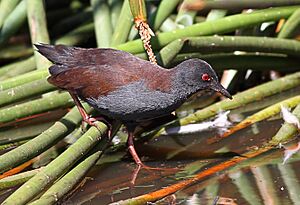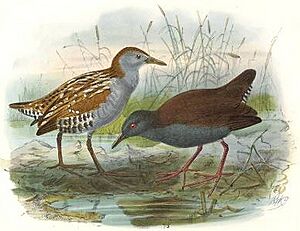Spotless crake facts for kids
Quick facts for kids Spotless crake |
|
|---|---|
 |
|
| Conservation status | |
| Scientific classification | |
| Genus: |
Zapornia
|
| Species: |
tabuensis
|
| Synonyms | |
|
Porzana tabuensis |
|
The spotless crake (Zapornia tabuensis) is a small bird that belongs to the rail family. These birds are found in many places, from the Philippines and New Guinea to Australia. They also live across the southern Pacific Ocean, reaching as far as the Marquesas Islands and New Zealand.
Contents
About the Spotless Crake
The spotless crake was first officially described in 1789. A German scientist named Johann Friedrich Gmelin gave it the scientific name Rallus tabuensis. This description came from earlier notes by an English bird expert, John Latham. Latham's notes were likely based on drawings made by Georg Forster. Forster traveled with the famous explorer James Cook on his second trip to the Pacific.
The spotless crake used to be in a different bird group called Porzana. Now, it is part of the Zapornia group. The name tabuensis comes from Tongatapu, an island in Tahiti. This is where the first bird of this type was found. There are no different types (subspecies) of the spotless crake.
What Does It Look Like?

Adult spotless crakes are about 17 to 20 centimeters (7-8 inches) long. Their wings can spread 26 to 29 centimeters (10-11 inches) wide. They usually weigh between 40 and 50 grams (1.4-1.8 ounces).
Their head and neck are a bluish-grey color. Sometimes, they have a light grey or white patch on their chin and throat. Their back and wings are a dark reddish-brown. This color fades to a dark blackish-brown on their tail feathers. The underside of the bird is also bluish-grey. It turns blackish-grey under the tail.
The spotless crake has a black bill and bright red eyes. Its legs and feet are a reddish-pink color. It is hard to tell male and female spotless crakes apart just by looking at them.
Young spotless crakes look similar to adults. However, their colors are duller and browner. Their chin and throat have a white patch. Their back is dull brown, and their head and underside are dull grey-brown. Their eyes are brownish-orange at first. They turn red as the bird gets older. Their legs and feet can be olive-brown, brownish-grey, or brownish-flesh colored. These also turn red as they mature.
Spotless crakes make many different sounds. Scientists do not know what all the calls mean. Some calls include a bubbling sound and a sharp, high-pitched "pit-pit." They also make a "mook" sound that changes in loudness. A loud "purring" call is thought to be their song. This song is a fast series of notes, about 25 per second. It is their loudest call.
Where Do They Live?

Spotless crakes live across the South Pacific. This includes the Philippines, Moluccas, New Guinea, and Melanesia. They are also found in Australia, Tasmania, Norfolk Island, and Indonesia. In south-west Polynesia, they live in New Zealand.
In New Zealand, the spotless crake is also called pūweto. There are not many of them in the South Island. Only a few small groups live on the west and east coasts, and in Southland, New Zealand. In the North Island, they are more spread out, but still not common. Most sightings are near the top of the North Island. Important places for them include the Awarua-Waituna wetland in Southland, Great Barrier Island, and Tiritiri Matangi Island. They also live on many small islands off the coast.
Fossils of spotless crakes have been found in New Zealand. This shows they have lived there for a very long time. Because they are rarely seen, it is hard to know how many spotless crakes there are in New Zealand today.
It is thought that spotless crakes are rare in the South Island, New Zealand for a few reasons. One reason might be that the marsh crake, another type of rail, pushes them out of good habitats. Both birds like similar places to live. Another reason could be that spotless crakes do not like the colder weather in the South Island. They are mostly found in warmer coastal areas.
Spotless crakes are wetland birds. They prefer to live in swamps and wetlands with lots of thick plants. They build their nests in these dense areas. They can be seen looking for food in muddy spots near thick plants. If they feel unsafe, they quickly hide back in the plants. On some small islands, where wetlands are rare, they can live in dry forests. They prefer to live in areas with raupo plants. However, they can also be found in swamps with flax (Phormium tenax), tussock sedge (Carex secta), and cabbage trees (Cordyline australis). If their home is not perfect, they can move to a better spot nearby.
Life Cycle and Behavior
Reproduction
It is hard to study how spotless crakes mate. This is because they are shy and live in thick plants.
Their nests are made of woven grasses. They build them in patches of tussock sedge and raupo. Nests are usually found in large, thick, and tall areas of reeds, rushes, and grasses. The nests are built about 30 to 50 centimeters (12-20 inches) above the water. They are often close to other nest-like platforms.
Eggs are laid from late August to the end of January. A female usually lays between 2 and 5 eggs. The eggs are a dull creamy brown or pinkish color. They have faint chestnut spots. Both the male and female bird sit on the eggs to keep them warm. This takes about 20 to 22 days. It seems that more eggs are laid later in the season. For example, 3 eggs might be laid in August, but 5 eggs in December.
After hatching, the chicks stay in the nest for up to four days. They can catch live food when they are three days old. Both parents take care of the chicks for 4 to 5 months.
Food and Feeding
Spotless crakes eat both plants and animals. Their diet includes seeds, fruits, and shoots of grasses. They also eat leaves from water plants. For animals, they eat adult and baby insects, snails, crabs, spiders, and worms. They also eat dead animals and beetles.
Threats to Spotless Crakes
Spotless crakes are in danger from animals that hunt them. These predators were brought to the areas where the crakes live. The main hunters include cats, dogs, weasels, and rats. Cats seem to be the biggest threat. If a predator is near, parent crakes might pretend to be hurt. This helps distract the predator from their nest or chicks.
Other dangers to spotless crakes include losing their homes. Swamps are drained and cleared for farming. This happened a lot when Europeans first arrived. Water pollution and damage to wetlands from animals grazing are also big threats.



